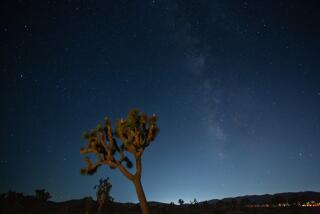Ancient Astronomers Mapped the Heavens and Aided Their Lives
- Share via
Ancient people who inhabited what today constitutes the United States and Canada as well as the hundreds of small islands in the South Pacific shared a common interest in astronomy, an interest in the movement of sun, moon and stars.
Scientists now know that American Indian and early Polynesian “sky watchers,” whose folklore and myths often likened astronomical bodies to gods, searched the heavens for clues to explain peculiarities in their daily lives.
But they also used the information for more practical purposes: to mark the passage of time, construct elaborate buildings and traverse uncharted seas.
“When we talk about the astronomy of ancient people we are not talking about the kind of astronomy that we have today,” said Ed Krupp, director of the Griffith Observatory. Krupp, an astronomer, is also the author of several texts on archeo-astronomy, the study of ancient sky lore.
“Evidence of an interest in the sky certainly covers the whole of North America and was only limited by the extent of our investigation,” he said.
Emerging evidence suggests that tribal Americans and early Polynesians were well aware of the positions of major star constellations thousands of years ago, gave them names and made ritual observations of astronomical phenomena.
“But they did not have a modern view of the solar system as we have,” Krupp said. “They thought that the center of the universe was, if not where they lived, then very close to it.
“They saw the same things that we see. In fact, they saw more with the unaided eye because they did not have the glare of city lights or pollution to obstruct the view.
“They certainly would not have missed the great grouping of Mars and Jupiter, whereas most of us don’t even know about it,” Krupp said. He noted that planetary alignments were well-documented by way of oral traditions and that ancient people knew when and where to look for them.
Krupp, who has studied the astronomies of North American tribes, particularly ancient California civilizations, said these societies had “no elaborate instruments because astronomy had symbolic value and helped to order people’s lives.”
“They watched the moon and stars to keep track of time because people need systems of direction, systems of calendars and systems of time-keeping to carry out everyday human activity. For them, it took on great ceremonial value.”
But, in the case of Polynesians, the knowledge gained from the position of the stars aided in the navigation of the Pacific and the settlement of the Hawaiian Islands about 1,600 years ago.
Scientists suggest that Polynesian “way finders” navigating the high seas in boats made of koa trees and topped with sails woven from leaves of the reedy pandanus tree sailed from the Society Islands area to Hawaii, guided by the stars.
“Bright stars rise and set on the horizon in the same position year ‘round,” said Cary Sneider, director of astronomy and physics education at the Lawrence Hall of Science in Berkeley. “So Polynesian navigators memorized the position of the stars.”
Knowledge of star positions also helped the navigators stay on course during daylight hours when stars are not visible in the sky.
They would use the sun as they would the stars and calibrate the sun against a star compass. The star compass is a concept, not an object--sort of a mental map of the skies and seas, Sneider explained.
On overcast nights Sneider said ancient sailors would navigate with the help of only a few stars, if they were visible, and the wave motion of the sea.
“Ocean swells are produced over hundreds of thousands of miles. The navigator would take a look at where the waves are coming from. If he got a few stars, he could check both the star and wave motion to reach his destination.”
Sneider said that scientists are learning more about how star navigation methods worked and that researchers “are now able to reconstruct some of the (star sailing) techniques probably used in ancient times.”
Sneider is participating in the Hukalea project, a sailing adventure aimed at reproducing the star sailing trip from the south Pacific to Hawaii.
Although studies of Polynesian and American Indian sky watchers are being conducted separately, the overwhelming similarities of sky watching suggest to Sneider common origins in Asia, the continent from which both groups migrated.
It has long been assumed that ancestors of all American Indians came from Siberia across the Bering Sea land bridge about 12,000 years ago. Studies by anthropologist Patrick Kirch of the Berk Museum in Seattle suggest that the smaller islands of the Pacific were populated by Asians about 11,000 years ago.
“Whether these were intentional or drift voyages is open to debate,” he said, but he doubts that sophisticated star navigation techniques were used in the earliest migrations to islands closest to the Asian continent.






